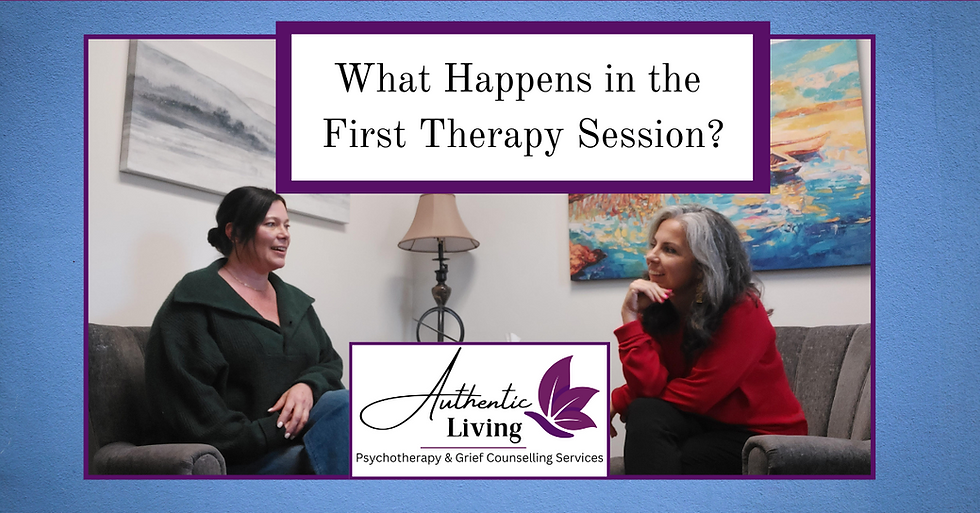Virtual Grief Counselling: What It Is, How It Works, and Whether It Is Right for You
- Aug 13
- 4 min read
Virtual grief counselling lets you meet with a therapist by secure video or phone so you can receive support wherever you are. For many people, online grief therapy is just as effective as in-person care; it can also be easier to start when leaving home feels hard.

What the research says: virtual care is as effective as in-person for many people
Multiple systematic reviews and meta-analyses report that psychotherapy delivered by videoconference performs similarly to in-person therapy on key outcomes like symptom reduction and client satisfaction; this includes strong results for CBT and trauma-related conditions. In plain terms: people tend to get better at similar rates whether sessions are online or face to face.
Numerous studies show online therapy delivers outcomes comparable to in-person sessions:
A meta-analysis of videoconference-based mental health therapy showed that online therapy results are equivalent to in-person services for mood and anxiety disorders (see Clinical Psychology Review meta-analysis: [Batastini et al., 2020]
Web-based grief interventions have demonstrated significant improvements in grief, depression, PTSD, and anxiety—both immediately after treatment and sustained up to three months later (see Yao et al., 2025 meta-analysis: [BMC Palliative Care, March 2025].
A broader systematic review also supports the effectiveness and feasibility of internet-based and mobile interventions for normal and complicated grief (see BMJ Open protocol: [Luppa et al., 2020].
This body of research confirms that virtual grief counselling is not only effective—but for many, it is equally as impactful as traditional therapy.
Pros and Cons of Virtual Grief Counselling
Pros:
Convenience: Join sessions from home; no travel needed.
Comfort: Familiar surroundings may support deeper emotional work.
Accessibility: Ideal for those in remote areas or with mobility limitations.
Consistency: Easier to maintain continuity during illness, travel, or unexpected events.
Privacy: Anonymity of your own space may reduce anxiety.
Cons:
Technology challenges: Internet disruptions or device issues can interrupt sessions.
Privacy concerns: Finding a quiet, secure space at home can be tricky.
Digital fatigue: Longer therapy sessions can feel draining on screen.
Safety limits: In serious mental health crises, in-person care or local emergency support may be needed.
Reduced nonverbal cues: Video may limit subtle communication that occurs in person.
Who Benefits Most (and Who May Need Another Option)
Virtual grief counselling is a good match for:
People with reduced mobility, chronic pain, or transportation challenges.
Those in rural or underserved areas without nearby mental health specialists.
Caregivers, parents, or professionals needing flexible scheduling.
Clients who prefer working through grief in the privacy and comfort of their home.
Individuals experiencing prolonged grief, PTSD-like symptoms, or seeking structure and access to specialized therapists.
It may not be the best fit if:
You are currently experiencing suicidal thoughts, self-harm urges, or crisis-level distress.
You lack reliable internet or private space for sessions.
You prefer hands-on or somatic therapies that require in-person tools or environments.
You are dealing with severe cognitive impairment and technology is a barrier.
What to Expect in a Virtual Grief Therapy Session
Easy tech setup: You receive a secure video link; preparing your device and testing audio/video helps ensure smooth sessions.
Collaborative agenda: Sessions are tailored to your needs—your therapist will check how you’re doing and set an agenda together.
Processing grief: This may include exploring memories, naming emotions, creating meaning, or coping plans.
Choice-driven experience: If a suggested activity is uncomfortable, the therapist will offer an alternative—this is your process, and collaboration matters.
Tools and integration: You may receive secure resources, worksheets, or short home practices to support your healing between sessions.
Privacy planning: Tips include using headphones, choosing a quiet spot, and setting boundaries with household members.
Getting Started: Practical Tips
Use a device you trust; ensure your browser or app is updated.
Create a calming space: bring water, tissues, a blanket.
Let household members know you need quiet time during sessions.
Leave a buffer after each session for self-care—light walking, reflection, or rest helps settle feelings.
Virtual Grief Counselling at Authentic Living London
At Authentic Living London, we understand that grief support needs to be accessible, flexible, and compassionate. That is why we offer virtual grief counselling for clients across Ontario. Whether you are navigating the loss of a loved one, experiencing anticipatory grief, or facing the complex emotions of losing someone who is still alive, our trained therapists are here to help.
Our online sessions are conducted through secure, privacy-compliant video platforms, so you can connect from the comfort of your own home without worrying about confidentiality. This can be especially valuable for those who have mobility challenges, live in remote areas, or simply feel more comfortable in their own space.
Our therapists, including practitioners who have both specialized training in grief therapy and lived experience with loss, bring empathy, understanding, and effective tools to help you process your feelings and find ways to live alongside your grief. Every session is collaborative, meaning you have a voice in the direction of your therapy. If you are not comfortable with a suggested activity or discussion, we will offer alternatives so that your healing process feels safe and personalized.
You can book a virtual grief counselling session with us at a time that works for you, knowing you will receive the same quality of care and expertise as our in-person clients.











Comments